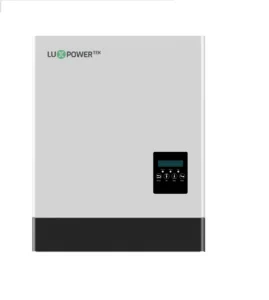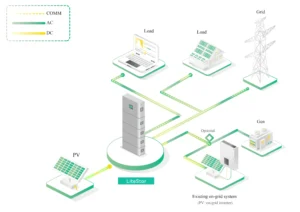Have you ever seen a solar system? It comprises the following things:
- Solar panels— they produce energy.
- Batteries— they store energy.
- Inverters— they transform energy.
Solar panels are useless until you have the inverter to convert the energy. The solar energy comes from DC power.
Guess what? Appliances can’t use DC power for their operations. They rely on AC power!! So, we have to consider the options like inverters.
But inverters have different types and options. Today, we will dig deep into one of the best hybrid solar inverters.
Let’s break it into various pieces!
What is a Hybrid Solar Inverter?

Before you understand the inverter function, learn about the solar panels. Photovoltaic cells trap sunlight and transform solar energy into DC power.
However, the electrical appliances use the AC power. Therefore, the direct consumption of solar energy isn’t a feasible idea.
Inverters transform the energy from DC into AC. This energy is used to charge and operate the appliances.
However, the normal inverter works one way— DC to AC. You must deploy another inverter to bring the energy back to DC for battery storage. It can be a complex and tricky deal for the solar system as a whole.
Hybrid Inverters are the perfect solution in this case. They work both ways— AC to DC and back to AC.
How does Hybrid Solar Inverter work?
The hybrid inverter works instead of two inverters. It fulfills the needs of grid-tied and battery-tied inverters. Based on the multi-modal functionality, we know the principles of hybrid solar inverters.
-
Grid-Tied Mode
In Grid-tied mode, the energy production occurs from the solar cells. They feed the DC energy that the inverters convert into the AC. The power and stable connection compatibility rely more on the hybrid inverters. They offer a safe and elegant experience to the users.
-
Off-grid mode
Off-grid mode is an operation mode independent of the public power grid, which enables the device to autonomously obtain and manage power without external power supply. This mode is often used in remote areas or emergency situations to ensure continuous power supply and improve energy autonomy and safety.
-
PV charge mode
PV charge mode is a specialized charging mode designed for solar panels, allowing them to efficiently convert solar energy into electricity. This mode is ideal for off-grid or hybrid power systems, providing a reliable and sustainable energy source.
-
Forced discharge mode
-
AC charge mode
AC charge mode is a mode used for charging electric vehicles. It uses an AC power source to convert electrical energy into a current and voltage suitable for charging electric vehicles. In order to effectively and quickly charge the battery of electric vehicles, it provides a convenient charging solution.
Battery Backup mode is a feature that allows electronic devices to switch over to a battery power source in the event of a power outage. When activated, Battery Backup mode ensures uninterrupted operation of devices, providing peace of mind during unexpected power interruptions.
Peak-shaving mode is a power adjustment mode used to balance the load of the power grid by reducing the load demand during the peak period of power demand. This mode can effectively reduce the load pressure of the power system and improve the stability of the power grid.
Pros and Cons of Hybrid Inverters
If you are opting for the Hybrid Inverters, consider the various points. Include the positives and negatives of inverters and explore them right away!
Pros
-
Two-in-one functionality
There is no need to purchase two inverters for the one. Instead, get one for the two. The Hybrid Inverter works as a simple inverter integrated with a rectifier. Two-way energy conversion reduces the hassles of purchasing and installing two inverters simultaneously.
-
Simplified Operations
The solar system already has many panels, batteries, and inverters connected to the chain. Adding two more inverters can make it more complex. On the other hand, introducing hybrid inverters can simplify the whole operation. First, it reduces the number of inverters.
Second, it functions independently. Therefore, a Hybrid Inverter can be the priority for many users.
-
Gird Independence
If you are relying on the grid system, don’t worry. Your power supply will still be there with a hybrid inverter.
The Hybrid Inverter stores the energy in the batteries. Once the grid fails or a power outage occurs, it routes the energy from batteries to the appliances without depending on the grids. Such an approach makes energy availability non-stop without dependence on the grid system.
-
Efficient Energy Management
The instant action of the energy supply can provide the energy on time. Such seamless management elevates the trust in the production setup. Moreover, the system operates with excessive energy storage in the batteries.
Whenever energy is needed, the inverters bring it back to the appliances. Such a flow of energy guarantees the streamlined operations of devices.
-
Cost Savings
There is no need to rely on the electricity during the peak hours. Instead, the solar system can fulfill this need efficiently. Hybrid Inverters make it seamless by transmitting the energy during peak time.
It can cut off the supply during the off-peak hours. Such an ideal strategy not only saves energy but also reduces electricity bills.
Cons
-
High Initial Costs
Hybrid Inverters do the work of the two inverters. Therefore, they are more expensive compared to the normal inverters. Initially, it is a more expensive investment than the overall benefits. However, it is a worthy investment in the long term.
-
Compatibility Issues
Maybe hybrid inverters are not compatible with your installed solar system. It can do nothing but create a headache for you. You can’t drive the required energy usage and might stick to the reduced consumption.
-
Battery Dependence
Hybrid Inverter systems have a chain of batteries for energy storage. Without batteries, they can’t fulfill energy needs in power failures.
LuxPowerTek Hybrid Inverters

LuxPowerTek Hybrid Inverters are talk-of-the-town because of endless power transmission and effective output. They offer multifunction access to the user.
The positive points about the LuxPowerTek inverters include:
- Advanced Technology. LuxPowerTek has upgraded the technology of its hybrid inverters. Therefore, you can generate more energy and make your connections a seamless experience.
- Compatible. Inverters are equally effective for all places, whether residential or commercial sectors.
- Affordable. Make more energy and economize your system. Even our hybrid inverters are a cheaper solution that is available at reduced prices.
Conclusion
Do you know the most crucial point about hybrid inverters? It is their selection. Since you need a non-stop power supply, fetch a power-packed hybrid inverter. Hunt down the top brands, such as LuxPowerTek.
Our hybrid inverters offer a streamlined experience. Flexible energy management with effective usage in residential or commercial setups can provide energy freedom.

